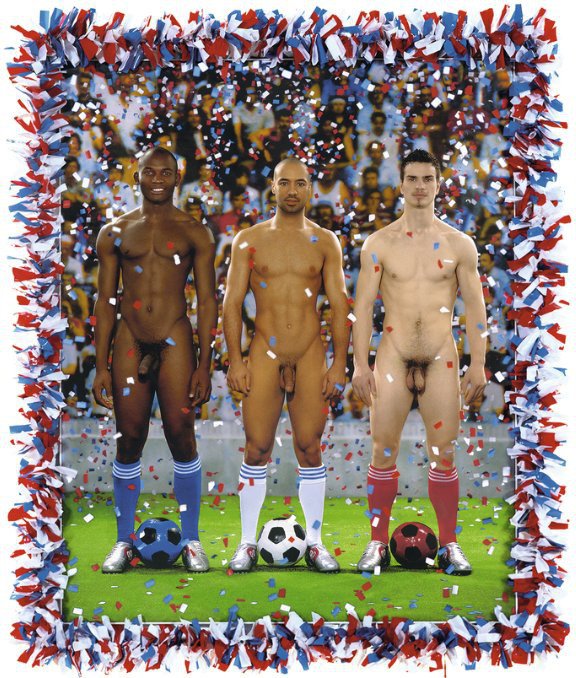Naked men
dal 18/10/2012 al 27/1/2013
Segnalato da
Albrecht Durer
Peter Paul Rubens
Angelika Kauffmann
Johann Heinrich Fussli
Antonio Canova
Jean Auguste Dominique Ingres
Leon Benouville
William Bouguereau
Paul Cezanne
Auguste Rodin
Ferdinand Hodler
Wilhelm von Gloeden
Henry Scott Tuke
Ludwig Hofmann
Gustav Klimt
Edvard Munch
Giovanni Giacometti
Aksel W. Johannessen
Renee Sintenis
Jean Cocteau
Egon Schiele
John Heartfield
Alfred Courmes
Pierre Molinier
Maria Lassnig
Andy Warhol
Alfred Hrdlicka
David Hockney
Günter Brus
Gilbert & George
Robert Mapplethorpe
Bruce Naumann
Urs Lüthi
Pierre & Gilles
Felix Gonzalez Torres
Keith Haring
Heimo Zobernig
Thomas Ruff
Elmgreen & Dragset
Ilse Haide
Douglas Gordon
Sam Taylor Wood
Pawel Althamer
Elke Krystufek
18/10/2012
Naked men
Leopold Museum, Wien
The show presents different artistic approaches to the subject, competing ideas of the ideal male model as well as changes in the concept of beauty, body image and values. Starting with the period of Enlightenment in the 18th century, the show focuses mainly on the time around 1800, on tendencies of Salon Art, as well as on art around 1900 and after 1945. The exhibition also features reference works from ancient Egypt, Greek vase painting and works from the Renaissance.

Previous exhibitions on the theme of nudity have mostly been limited to female nudes.
With the presentation “naked men” in the autumn of 2012 the Leopold Museum will
be showing a long overdue exhibition on the diverse and changing depictions of naked
men from 1800 to the present.
Thanks to loans from all over Europe, the exhibition “naked men” will offer an unprece-
dented overview of the depiction of male nudes. Starting with the period of Enlighten-
ment in the 18th century, the presentation will focus mainly on the time around 1800,
on tendencies of Salon Art, as well as on art around 1900 and after 1945. At the same
time, the exhibition will also feature important reference works from ancient Egypt,
examples of Greek vase painting and works from the Renaissance. Spanning two centu-
ries, the presentation will show different artistic approaches to the subject, competing
ideas of the ideal male model as well as changes in the concept of beauty, body image
and values.
A changing concept – reassessing established categories
“Over the past years the depiction of naked men has gained an unprecedented public
presence”, according to Elisabeth Leopold and Tobias G. Natter, the two curators of the
exhibition. “At the same time, we want to respond with this exhibition to the fact that
previously firmly established categories such as “masculinity”, “body” and “nudity” are
now being reassessed on a broad social level”.
The embodiment of a worldview
For centuries the male nude formed the basis of the curriculum of European art acade-
mies. This “educational” viewing of naked men meant that women were excluded from
an artistic education for the longest time.
Antiquity as a benchmark and pretext
The depiction of male nudes gained new
relevance around 1800 following Johann
Joachim Winckelmann’s claim: “The one
way for us to become great, perhaps inim-
itable, is by imitating the ancients” . Thus,
antiquity became a benchmark, if often
only a pretext, for a new image of men,
which often put the themes of nudity and
sexuality in controversial proximity.
Bathing men
Towards the end of the 19th century a new subject emerged with the informal depic-
tions of naked men bathing in the open air. This theme is presented in the exhibition
with works by Henry Scott Tuke, Paul Cézanne, Edvard Munch and many others.
The naked self
Through the exponents of Austrian Early Expressionism, and most notably through
Egon Schiele, nudity experienced an artistic peak as an expression of (self-)externali-
zation at the beginning of the 20th century. A central concern during that time was the
relationship between internal and external truth.
New gender models and identities after 1945
Another main emphasis of the exhibition will be on the changes in the perception of
naked men after 1945, when new alternative ideals of masculinity met with compet-
ing gender identities in post-war societies. In art and culture, get-togethers of naked
men have received a new significance, as they are no longer merely perceived as active
subjects and conveyors of ideas, but also as explicitly erotic objects. The presentation’s
broad spectrum is further enriched with the inclusion of works by contemporary art-
ists who address questions about the determinants of gender and identities and assert
themselves through their art in the fight against political constraints and social repres-
sion.
Among others, works by the following artists will be shown in the exhibition: Albrecht
Dürer, Peter Paul Rubens, Angelika Kauffmann, Johann Heinrich Füssli, Antonio Canova,
Jean-Auguste Dominique Ingres, Léon Benouville, William Bouguereau, Paul Cézanne,
Auguste Rodin, Ferdinand Hodler, Wilhelm von Gloeden, Henry Scott Tuke, Ludwig Hof-
mann, Gustav Klimt, Edvard Munch, Giovanni Giacometti, Aksel W. Johannessen, Renée
Sintenis, Jean Cocteau, Egon Schiele, John Heartfield, Alfred Courmes, Pierre Molinier,
Maria Lassnig, Andy Warhol, Alfred Hrdlicka, David Hockney, Günter Brus, Gilbert &
George, Robert Mapplethorpe, Bruce Naumann, Urs Lüthi, Pierre & Gilles, Felix Gonza-
lez-Torres, Keith Haring, Heimo Zobernig, Thomas Ruff, Elmgreen & Dragset, Ilse Haider,
Douglas Gordon, Sam Taylor-Wood, Pawel Althamer, Elke Krystufek and many others.
Image: Pierre & Gilles, Vive la France, 2006 © Privatsammlung, Courtesy Galerie Jérôme de Noirmont
Press / Public Relations- Mag. Klaus Pokorny, tel +43.1.525 70-1507, fax +43.1.525 70-1500, presse@leopoldmuseum.org
Opening 19 october
Leopold Museum
Museumsplatz 1 - Wien
Daily except Tuesday from 10 a.m.-6 p.m.
Thursday 10 a.m.-9 p.m



